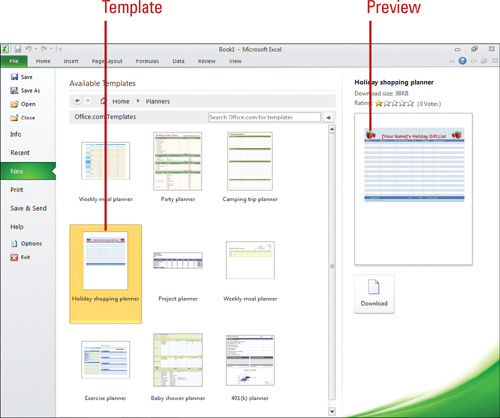Creating a Workbook Using a Template
Excel
provides a collection of professionally designed templates that you can
use to help you create workbooks. Start with a template when you have a
good idea of your content but want to take advantage of a template’s
professional look. A template
is an Excel workbook file that provides you with a unified document
design, which includes themes, so you only need to add text and
graphics. In the New screen, you can choose a template from those
already installed with Excel or from the Microsoft Office.com Online Web
site, an online content library. You can choose an Office.com template
from one of the listed categories.
Create a Workbook with a Template
 Click the File tab, and then click New.
Click the File tab, and then click New.
 Choose one of the following:
Choose one of the following:
- Click Recent templates, and then click a recently used template.
- Click Sample templates, and then click a template.
- Click My templates to open a dialog box.
- Click New from existing to open a dialog box to select a template file.
- Click an Office.com Templates folder (if needed), and then click a template.
 To navigate, click the Home, Next, or Previous button.
To navigate, click the Home, Next, or Previous button.
 Click Create or Download.
Click Create or Download.

 If necessary, click the template you want, and then click OK.
If necessary, click the template you want, and then click OK.

Opening an Existing Workbook
You
can open an Excel workbook and start Excel simultaneously, or you can
open an Excel workbook file or file created in another spreadsheet
program after you start Excel. You can open an existing workbook from
within Excel by using the File tab (New!).
On the File tab, you can choose the Open command to locate and select
the document you want or choose a recently used document from the Recent
Workbooks or Recent Places list on the Recent screen (New!).
Similar to the Windows Start menu, the Recent Workbooks or Recent
Places list allow you to pin documents to the list that you want to
remain accessible regardless of recent use. The Pin icon to the right of
the file name on the File tab makes it easy to pin or unpin as needed.
Open a Workbook from the Excel Window
 Click the File tab, and then click Open.
Click the File tab, and then click Open.
 If you want to open a specific file type, click the Files of type list arrow, and then click a file type.
If you want to open a specific file type, click the Files of type list arrow, and then click a file type.
 If the file is located in another folder, click the Look In list arrow, and then navigate to the file.
If the file is located in another folder, click the Look In list arrow, and then navigate to the file.
 Click the Excel file you want, and then click Open, or click the Open button arrow, and then click one of the following options:
Click the Excel file you want, and then click Open, or click the Open button arrow, and then click one of the following options:
- Open Read-Only to open the selected file with protection.
- Open as Copy to open a copy of the selected file.
- Open in Browser to open the selected Web file in a browser.
- Open in Protected View to open the selected file in protected view (New!).
- Open and Repair to open the damaged file.

|
The Excel Viewer is a program
used to open and view workbooks on computers that don’t have Microsoft
Excel installed. The Excel Viewer is available for download from the
Microsoft Office.com Online Web site in the downloads section. Check the
Microsoft Web site for software requirements.
|
Open a Recently Opened Workbook
 Click the File tab, and then click Recent.
Click the File tab, and then click Recent.
 Click the workbook you want to open in the Recent Workbooks list or a folder in the Recent Places list.
Click the workbook you want to open in the Recent Workbooks list or a folder in the Recent Places list.
- Pin a document/folder. Click the Pin icon (right-side) to display a green pin (document is pinned) on the Recent Workbooks or Recent Places list (New!).
- Unpin a document/folder. Click the Pin icon (right-side) to display a grey pin on the Recent Workbooks or Recent Places list (New!).

Did You Know?
You can add recently used documents to the File tab (New!). Click the File tab, click Recent, select the Quickly Access This Number Of Recent <documents> check box, and then specify the number of documents you want to display.
You can change the number of recently opened files that appear on the File tab.
Click the File tab, click Options, click Advanced, change the Show This Number Of Recent Documents list, and then click OK.
You can change the default file location of the Open dialog box.
Click the File tab, click Options, click Save, enter a new location in the Default File Location box, and then click OK.
Microsoft Excel can open a
variety of different file formats using the Open dialog box. These
include All Web Pages, XML Files, Text Files, All Data Sources, Access
Databases, Query Files, dBASE Files, Microsoft Excel 4.0 Macros,
Microsoft Excel 4.0 Workbooks, Worksheets, Workspaces, Templates,
Add-Ins, Toolbars, SYLK Files, Data Interchange Format (DIF), and Backup
Files.